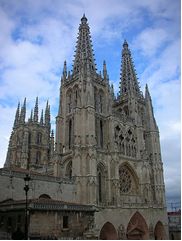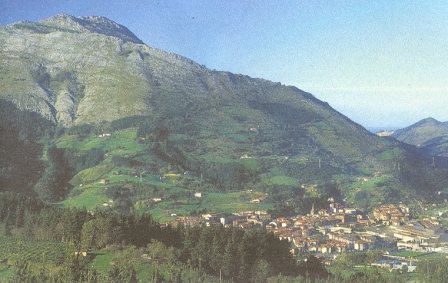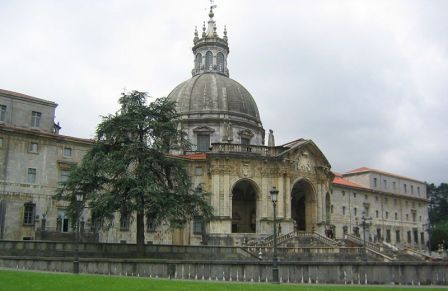
October 17
It was 34 degrees and clear as we boarded the bus. I clicked a picture of the Burgos cathedral as we drove through the empty Saturday morning streets.

We began to climb the mountains headed for the birthplace of Ignatius Loyola (Inigo de Loyola was born in 1491 in Azpeitia in the Basque province of Guipuzcoa in northern Spain in the Castle of Loyola--his family name), my confirmation patron saint, founder of the Jesuits. Fr. Frank read the letter of St. Ignatius of Antioch, how he wanted to be brave in facing the lions, on this his feast day. The sun glared through the windows from the East as we watched the final part of the Pope John Paul II movie, Karol. Now we have more mountains to climb on our pilgrimage and in our own lives. We will ascend the Pyrenees to the Castle of Loyola in Azpeitia and then to Lourdes before this day is finished, a place where we can invoke Our Lady’s help for the challenges ahead. First, I need to read the background material I printed off the Internet and to try to memorize about 20 basic French phrases to communicate at least a little. Javier is sad to be leaving Spain. Miguel will return to Spain and we will have a new bus driver in France.
As we neared St. Ignatius’ home, we entered Spanish Basque country with lush green valleys, solid rock mountain peaks, and a plethora of long, winding tunnels. Patches of clear cut forest were interspersed in a politically correct way between patches of tall trees, spring green pastures, and white houses with red roofs.
You expected to see Heidi with her goats on the hillsides. Massive industrial complexes occasionally blighted the alpine beauty.
The place where St. Ignatius was born is in a spectacular valley surrounded by steep mountains. Here most of the signs were in Spanish and Basque.

We followed an audio tour narrated by an Irishman to the place of Ignatius’ birth and conversion. Fr. Frank said Mass in the room where Ignatius, the wounded soldier, was converted.
Touring the Loyola castle and the Basilica we saw a statue of Inigo, the wounded soldier,
and a gilded statue depicting his conversion….
…then the Basilica and its main altar

Leaving Jesuit country behind, the bus snaked its way along a river in a deep canyon. Like tiny cotton balls sheep dotted green mounds beneath the mountain peaks. Groups of puffy, white clouds muted the afternoon sun. Tidy gardens waning in the fall weather popped up near mountain homes and villages as the bus rocked rhythmically on the curves in a monotonous groan. Periodically we stopped at toll booths. A sign read: “Donastia S. Sebastian.” Happy Spanish bulls grazed the autumn grass oblivious of their fate. As we descended a mountain pass, we could see the ocean, the distant beach at St. Sebastian, and a statue of the Sacred Heart on top of a hill overlooking the city. What a great place for a pilgrim lunch.

A quick pizza con queso y carne con CocaCola Light was just right. We walked along the coast and took pictures of the beach, the harbor, the island, and some Latin lovers who also took our picture.
One of the lovers asked a woman walking by to take the picture of the four of us. I still wonder why they wanted a picture together with some old American couple. From there we wound our way back to the main boulevard and searched for a bathroom. MacDonald’s was a sure bet, so we headed in that direction. The bathroom consisted of one overused toilet for men and one for women. Toilet paper was long gone so we were fortunate to be carrying extra Kleenex. So much for European toilets.
By 3:30 we had clicked a few more pictures, then boarded the bus for our pilgrimage to Lourdes. It was sad leaving this spectacular vacation spot of Ferdinand and Isabelle.
We watched the classic movie, Song of Bernadette, to begin our three hour journey to the Pyrenees in France. A half hour out of town past a few more resort towns at a toll booth Javier stopped the DVD to say Bienvenu a France. After dozing off, I woke up to the French countryside. Red tile roofs were replaced by black, grey, and brown ones. Fields of dry corn, hardwood trees, chateaux, and lakes make up the new landscape.
Now there were rolling hills and flat ground beyond the mountains, then more tall mountains partially covered by rain clouds to the southeast as we approached Lourdes. Soon we were driving on a narrow road edged by corn fields and quiet country homes. Then up a windy road to the base of the mountains. Welcome to Lourdes. The bus squeezed through a blur of souvenir shops ending in an open field with our first view of the Basilica, and then it turned past more souvenir shops with bustling crowds like China town in San Francisco. Before the sun set and before dinner, we had time for our first picture of the Basilica.
After an excellent lamb chop dinner with a fine French wine and raspberry sorbet and sherbet dessert we walked to the Basilica square for the rosary. Unlike Fatima, everyone walked in the procession holding candles.
A few men are making a movie of a young adult, terminally ill girl, Bernadette, who joined our pilgrimage here. As Javier pushes her wheel chair and talks to her, the cameraman is busy getting footage. After the procession we visited the grotto, placed candles in the racks to burn out, then washed our faces and drank the grotto’s water from the faucets nearby. By 11:00 we were back in our room ready for welcome sleep.